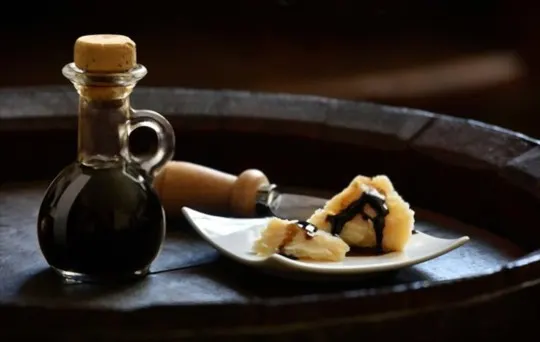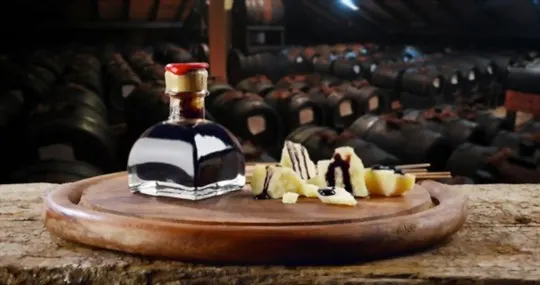Is it wine? Is it vinegar? Or is it a combination of both? Whatever it is, balsamic vinegar is one condiment that you need on your kitchen countertop.
This strong-tasting vinegar is of Italian origin and used for several purposes.
And they are not like regular kinds of vinegar.
Be ready to splash some cash if you decide to buy a bottle (because they are so expensive).
Because it is made of grapes and fermented, some people think it is wine.
But you cannot drink it like wine unless you want digestive problems.
So, what does balsamic vinegar taste like? Does it taste like standard vinegar? Does it taste like wine? We will answer these questions and more below.
What Is Balsamic Vinegar?

Balsamic vinegar is a strongly-flavored type of vinegar native to Italy.
They are made using fresh grape juice.
Despite the name, balsamic vinegar does not contain any traces of balsa or balsam.
The traditional version of balsamic vinegar comes from Modena, Italy.
It is reddish-brown but surprisingly does not use red grapes.
Making balsamic vinegar is a long process and is very interesting.
The grapes are crushed to obtain “must” which is boiled until it thickens.
Grapes like Trebbiano or Lambrusco are classic options.
The syrup is stored in large wooden barrels or kegs and left to age.
Every year, manufacturers transfer the vinegar into smaller containers making the flavor even better.
We get a thick, concentrated, and strong-tasting vinegar at the end.
The aging process lasts anywhere between 10-100 years.
And the longer it ages, the better it tastes.
The price tag also depends on how long the vinegar is aged.
What Does Balsamic Vinegar Taste Like?

Balsamic vinegar has a vibrant and tart-like flavor.
It is very tangy, as you would expect with vinegar.
It has a dark brownish-red color even though it is made of white grapes.
It has a subtle sweet taste like honey or molasses.
The aroma is also very strong and intense because of fermentation.
You can also get some earthy, slightly nutty, fruity notes.
But the most important factor here is age.
The longer balsamic vinegar ages, the sweeter it tastes.
This “liquid gold,” aged for up to twelve years, is thicker in texture and smooth and luscious.
However, it is only mildly bitter in taste.
There is a mix of sweet, bitter, pungent, and fruity flavors all mixed in one.
Balsamic vinegar is aged in wooden barrels made of a variety of woods.
They also play a part in how it tastes.
Woods like oak, acacia, chestnut, etc.
, have a distinct scent that mixes with the vinegar during aging.
Some think balsamic vinegar tastes like a Coke when mixed with sparkling water.
The short answer here is no.
It tastes like a fizzy version of vinegar.
In case you are wondering, balsamic vinegar also tastes nothing like white vinegar.
For starters, one costs hundreds of dollars, while you can get the other for around 5-10 dollars.
There are four main types of balsamic vinegar.
They are Artisan, Industriale, Condimenti, and Imitation.
Artisan is the original and authentic version, made exclusively in Reggio and Modena.
Imitation balsamic vinegar is just a knockoff that manufacturers label as “balsamic vinegar.
”.
How to Use Balsamic Vinegar for Cooking?

Want to add a unique blend to your dishes? Balsamic vinegar is your best bet.
It tastes bitter, sweet, pungent, and tangy at the same time.
That is sure to make your dishes pop out.
You can use it like a vinaigrette and drizzle it over a veggie salad.
This will give the plain-tasting vegetables a whole new flavor.
Add some cheese slices to this, and you’re in for a treat.
You can splash some on top of your meats or use it as a dipping sauce.
And you already know how well savory and tangy flavors complement each other.
Adding balsamic vinegar to soups and broths can also take it to another level.
Whether it is a meat or veggie-based soup, you can expect a festival of flavors.
You can also make interesting balsamic vinegar-infused drinks.
Mixing it with seltzer, alcohol, and herbs is an interesting choice.
Plus, you have the English cocktail drink called Shrubs, which combines vinegar, herbs, and fruits.
And who says vinegar is just for Savory dishes? You can go bold and add a dash to your sweet dishes.
Balsamic vinegar is thick, unlike other kinds of vinegar.
Plus, it tastes sweet because of its source (the grapes).
They pair well with crackers, fruits, etc.
If your dishes are too sweet, balsamic vinegar will balance everything by adding a tangy element.
Conclusion
Traditional balsamic vinegar is the result of years of aging and labor.
Modern methods have made it easier to produce them in bulk.
But there is no comparison to the authentic one.
It has a particular flavor that takes work to replicate.
No modern machinery or methods can come close to something vintage-tasting like traditional balsamic vinegar.
You might want to cheap out and buy the knockoffs on a budget.
But remember, you will not get anywhere near the authentic flavors.
Buying original balsamic vinegar is an investment.
It is worth every dollar you spend.
Just think about how it affects the flavors of the dishes you have in mind.

Carrie is a food writer and editor with more than 15 years of experience. She has worked for some of the biggest names in the food industry, including Bon Appétit, Food & Wine, and Martha Stewart Living.
As the Editor in Chief of IntroChicago.com, Carrie oversees all of the content on the site. She also manages the team of contributing writers and editors, who help to create delicious recipes, helpful tips, and informative articles that you’ll find on the site.
A native of the Chicago area, Carrie is passionate about all things food. She loves trying new restaurants and experimenting with new recipes in her kitchen. She’s also a graduate of the Culinary Institute of America, so she knows a thing or two about food!
